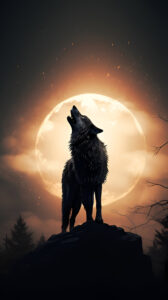Colossal Biosciences Achieves De-Extinction Milestone.
Introduction: From Game of Thrones to Genetic Engineering
Ever since HBO’s Game of Thrones, The Dire Wolf has captured the imagination of many as it serves as the companion of House Stark and is depicted as both loyal and fierce; however, it has recently become an object of modern scientific interest. Resurrecting the real life dire wolf, which lived in Ice Age ecosystems, is now a possibility thanks to the work of Colossal Biosciences, a leader in de-extinction biotechnology. Their latest work which marries darwinsim with pop culture and genetic engineering is sure to make people think about modern ethics, science, and conservation.
The Science Behind De-Extinction: How CRISPR and Ancient DNA Made Dire Wolves Possible
CRISPR Technology: Rewriting the Code of Life
CRISPR-Cas9 underpins Colossal’s achievement as it is a gene-editing tool which helps in scrutinizing, and modifying the DNA of an organism. For instance, researchers have compared the genome of an extinct dire wolf, which was sequenced from fossilized remains, with its closest living relative, the gray wolf (Canis lupus). Adaptations which facilitated a larger size, hypercarnivore diets, and stronger jaws were noted.
In screeding genetic patches, the company aims to replicate the steps taken to bring back the woolly mammoth, another company Ice Age icon. Colossal’s team sprinkled CRISPR editing on gray wolf embryos and directly implanted dire wolf specific genes within their DNA.
Ancient DNA and the Challenges of Resurrection
De-extinction is not as easy as Jurassic Park depicts. Most of the time, ancient DNA is incomplete and spoiled. However, reconstructing a dire wolf’s genomic blueprint is possible due to advancements in paleogenomics—the study of ancient genomes. A dire wolf was discovered to be genetically separate from gray wolves in a 2021 Nature study. They evolved in isolation for millions of years in the Americas. This differentiation is important: bringing back Canis dirus is more complex than simple cloning; it requires a mixture of methods.
Scientific References:
Dire Wolves in Pop Culture: Game of Thrones’ Role in Modern Mythmaking
From Legend to Mainstream Fame
Dire wolves were alive for more than 100,000 years, but their cultural resurgence came from Game of Thrones. The Stark direwolves – Nymeria, Ghost, and Shaggydog – represented fierce loyalty and the wilderness which captivated so many. This form of pop culture has sparked interest in Ice Age megafauna in the same way that Jurassic Park did for dinosaurs.
Colossal’s marketing strategy is nostalgic in an unexpected way. Their announcement video opens with a CGI dire wolf that captures the essence of the Stark sigil. To top it off, the famous Game of Thrones theme is played but in a chilling manner. This is a perfect example of how fiction meets science and creates the new attainable goal of de-extinction.
Separating Fact from Fiction
In the TV series Game of Thrones, direwolves are shown as almost magical creatures that are immensely intelligent. They were nothing more than hyper-specialized predators. Real dire wolves weighed as much as 150 pounds (68 kg) and fed on enormous herbivores such as bison. Unlike the solitary TV versions, fossil evidence suggests they may have lived in packs, similar to modern wolves.
Bridging Myth and Science: Why De-Extinction Matters
Ecological Restoration and Climate Resilience
Colossal claims bringing back megafauna such as dire wolves could reinstate important ecological functions. As apex predators, dire wolves controlled prey population and maintained biodiversity. Today, they could help manage invasive species control, or aid rewilding initiatives.
The firm also points out the climate advantages: large herbivores such as mammoths can protect Arctic permafost by trampling insulating snow, leading to the preservation of greenhouse gasses. Dire wolves could to some extent help control herbivore populations to sustain those ecosystems.
Ethical Debates: Playing God or Saving Nature?
Critics raise the ethical challenges of bioengineering – “playing God.” For instance, does environmental philosopher Dr. Emma Marris ask, “De-extinction risks diverting resources from saving endangered species. Is a hybrid dire wolf more valuable than a living gray wolf”? Warning of semi-intentional consequences, others suggest predators reintroduced may disturb present ecosystems.
Supporters counter that Cretaceous Park operates within human-shaped nature, which augments the purpose of civilization’s farming and city building. They view the Colossal Company’s work as proactive in an adjusted-by-climate-change world.
The Future of De-Extinction: What’s Next for Colossal Biosciences?
Beyond Dire Wolves: A Menagerie of Lost Species
Colossal’s pipelines involve the woolly mammoth, the dodo, and the Tasmanian tiger. Each project combines gene editing, cloning, and selective breeding. The company has also raised $225 million, which shows investor confidence in “applied evolutionary biology.”
Regulatory and Cultural Hurdles
Before dire wolves roam the earth again, Colossal has to deal with regulations first. The U.S. Fish and Wildlife Service and international organizations like CITES will weigh in on releasing genetically engineered species. Public perception matters just as much: a 2023 Pew survey reported 60% of Americans back de-extinction efforts if it helps conservation.
Conclusion: A New Era of Coexistence
Bringing back the dire wolves is rooted in more than Colossal Biosciences’ scientific wit; it exemplifies how far humanity has come in terms of its relationship with nature. While we grapple with the consequences of our own recklessness, dire wolves can serve as either ecological guardians or unrestrained ethical quandaries. Nevertheless, the constant remains that the boundary between fiction and reality is almost non-existent in this case. As Colossal Biosciences restores nature’s history, this project urges the world to rethink the conservation philosophy during the Anthropocene Era.
For the latest and trending news, stay up to date with us.






